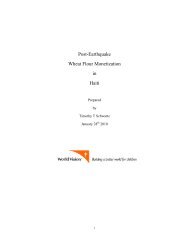Right to Livelihoods in Haiti
Focus on egg production and rural household livelihood strategies
Focus on egg production and rural household livelihood strategies
Create successful ePaper yourself
Turn your PDF publications into a flip-book with our unique Google optimized e-Paper software.
6<br />
<strong>in</strong>dustry. Chicks were permitted <strong>to</strong> be imported with only a <strong>to</strong>tal of 7% surcharge for taxes, verification<br />
xi xii<br />
and account<strong>in</strong>g costs.<br />
The five years s<strong>in</strong>ce the 2010 earthquake have brought more changes. An avalanche of low <strong>in</strong>terest<br />
fund<strong>in</strong>g programs and that came about after the earthquake, helped galvanize entrepreneur <strong>in</strong>terest <strong>in</strong><br />
the sec<strong>to</strong>r. Projects launched <strong>in</strong>clude,<br />
USAID/ WINNER dans la région des Gonaïves (50.000 pondeuses)<br />
PDLH/OXFAM <strong>in</strong> Paillant (with AFAP)<br />
USAID/ HI FIVE dans la région des Cayes avec ASSAVIS.<br />
Pro-Huerta <strong>in</strong> the North (Argent<strong>in</strong>a)<br />
Core’s projects at Christian Ville <strong>in</strong> Gressier<br />
Christian Aid <strong>in</strong> the Sudest xiii<br />
EcoWorks International (EWI) <strong>in</strong> Ganthier<br />
Not least of all, <strong>in</strong> 2011 the Martelly adm<strong>in</strong>istration renewed the government’s commitment <strong>to</strong> <strong>in</strong>creased<br />
national production on all fronts, especially <strong>in</strong> the agricultural sec<strong>to</strong>r and, more than anyth<strong>in</strong>g else, <strong>in</strong> egg<br />
production. By 2012 <strong>Haiti</strong> had 721 facilities produc<strong>in</strong>g broilers and 25 produc<strong>in</strong>g eggs.<br />
Mak<strong>in</strong>g the growth possible were three significant hatcheries: <strong>Haiti</strong> Broilers (capacity = 400,000 chicks per<br />
month), JAVEC (100,000 chicks per month) and FACN (50,000 chicks per month). With a <strong>to</strong>tal capacity for<br />
these three operations of 550,000 chicks per month, if all the chicks were dest<strong>in</strong>ed <strong>to</strong> become lay<strong>in</strong>g hens,<br />
they could, <strong>in</strong> one year, enable <strong>Haiti</strong> <strong>to</strong> produce 6 million eggs per day, significantly more than market<br />
demand. It seemed <strong>in</strong> 2012 that <strong>Haiti</strong> could become self-sufficient <strong>in</strong> egg production. It also seems that<br />
the <strong>Haiti</strong>an government was keen <strong>to</strong> take advantage of the opportunity. xiv<br />
The Egg Embargo<br />
In June 2013, claim<strong>in</strong>g that the Dom<strong>in</strong>ican poultry <strong>in</strong>dustry was experienc<strong>in</strong>g an outbreak of aviary, flu<br />
the <strong>Haiti</strong>an government prohibited the importation of eggs from the other side of the island. 1 It was not<br />
the first time. A spate of H5N1 bird flu cases <strong>in</strong> 2008 resulted <strong>in</strong> a <strong>Haiti</strong>an embargo aga<strong>in</strong>st Dom<strong>in</strong>ican eggs<br />
someth<strong>in</strong>g that was imposed for the period 2008 – 2013 and never formally lifted. Instead the import<br />
deficit was made up for <strong>in</strong> 2008 and 2009 by importations from the US and thereafter the Dom<strong>in</strong>ican<br />
imports <strong>in</strong>formally resurged <strong>in</strong> the wake of the 2010 earthquake. Notwithstand<strong>in</strong>g, with<strong>in</strong> four days of the<br />
ban on Dom<strong>in</strong>ican eggs the PAHO (Pan American Health Organization) had <strong>in</strong>vestigated the 2012 case and<br />
xv xvi<br />
rejected the claim.<br />
The new embargo nevertheless rema<strong>in</strong>ed <strong>in</strong> place, help<strong>in</strong>g <strong>to</strong> promote national production through an<br />
<strong>in</strong>crease <strong>in</strong> prices and giv<strong>in</strong>g the <strong>Haiti</strong>an government—which due <strong>to</strong> its weak economic and trad<strong>in</strong>g status<br />
has the most liberal import tariffs <strong>in</strong> the Caribbean--a mechanism <strong>to</strong> restrict Dom<strong>in</strong>ican egg importation<br />
at will—i.e. through tighten<strong>in</strong>g and loosen<strong>in</strong>g control over smuggl<strong>in</strong>g. By 2014 heavily capitalized<br />
<strong>in</strong>dustrial <strong>Haiti</strong>an egg entrepreneurs were produc<strong>in</strong>g 6.45 million eggs per month. This was six times the<br />
1 million produced per month <strong>in</strong> 2006. The most promis<strong>in</strong>g encountered dur<strong>in</strong>g the course of this research<br />
is that of Ferme des Antilles, a modern state of the art facility <strong>in</strong> Cavaillon, Department of the South.<br />
1<br />
It was not the first time that the <strong>Haiti</strong>an Government had embargoed Dom<strong>in</strong>ican poultry products. It had done the<br />
same th<strong>in</strong>g <strong>in</strong> December 2008, after 115 cases of the bird flu were reported. Then <strong>to</strong>o smuggl<strong>in</strong>g quickly regulated<br />
supplies.
















